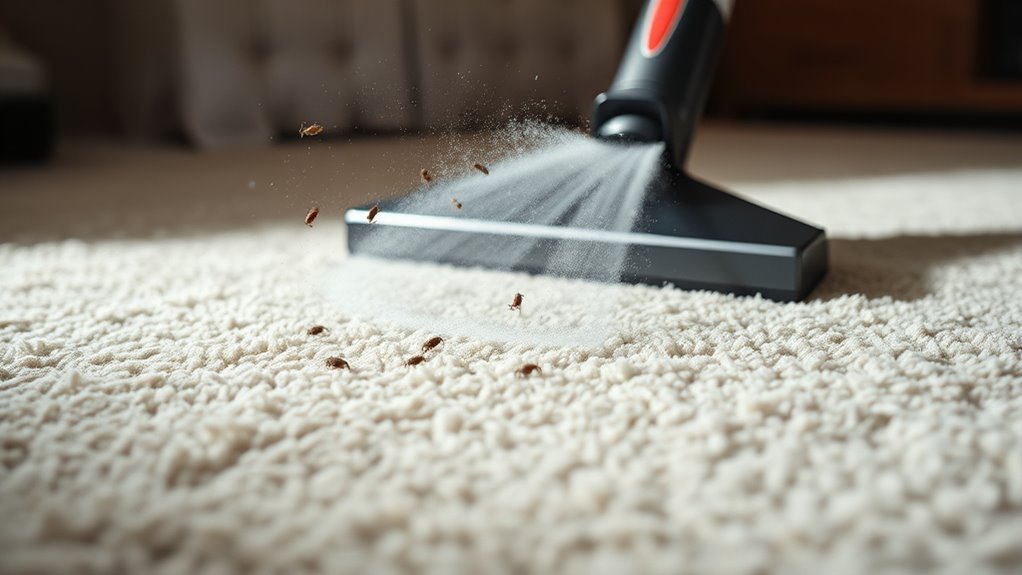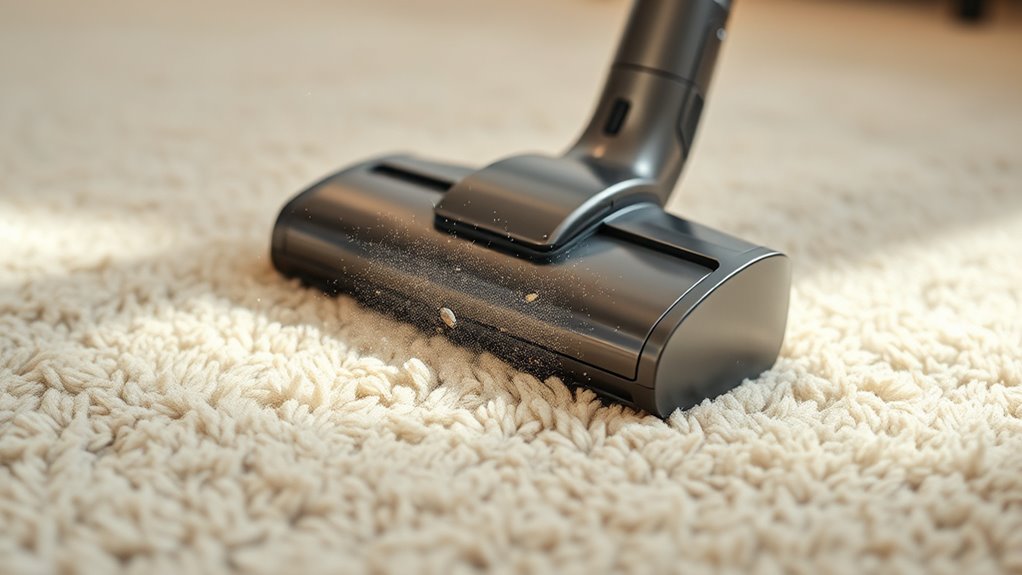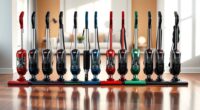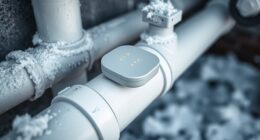To keep dust mites at bay, vacuum thoroughly with a high-quality vacuum equipped with a HEPA filter, which captures tiny particles like mites and allergens. Use slow, deliberate passes over carpets, upholstery, and bedding to dislodge and remove mites effectively. Must-know techniques include focusing on high-traffic areas and maintaining your vacuum regularly by emptying canisters and cleaning filters. Mastering these methods will boost your fight against mites—your home’s comfort depends on it.
Key Takeaways
- Use a vacuum with a HEPA filter and strong suction to effectively trap dust mites and allergens.
- Vacuum slowly and methodically to dislodge mites from fibers and surfaces thoroughly.
- Focus on high-traffic areas like bedrooms and living rooms where mites thrive.
- Regularly empty the vacuum canister or replace bags to prevent allergen dispersal.
- Maintain vacuum filters and parts routinely for consistent, optimal mite removal.

Have you ever wondered what tiny creatures are lurking in your home, causing allergies and respiratory issues? Dust mites are microscopic arachnids that thrive in warm, humid environments, feeding on dead skin cells shed by humans and pets. They’re invisible to the naked eye, but their presence can considerably impact your health. The good news is that proper vacuuming techniques play a critical role in mite eradication and keeping these pests at bay. Regularly maintaining your vacuum cleaner ensures it functions effectively, removing dust mites and their allergen-laden waste from your environment. A well-maintained vacuum creates a barrier against their proliferation, especially in high-traffic areas like bedrooms and living rooms.
When it comes to vacuum maintenance, choosing the right equipment is essential. Look for a vacuum with a high-efficiency particulate air (HEPA) filter, which captures tiny particles such as dust mites, pollen, and pet dander. A vacuum with strong suction power is indispensable for pulling up these microscopic pests from carpets, upholstery, and bedding. Remember, a vacuum isn’t just a cleaning tool—it’s your frontline defense in mite eradication. To maximize its effectiveness, empty the canister or replace the bag frequently, especially after cleaning heavily infested areas. Regularly inspect and clean the filters, following the manufacturer’s instructions, to maintain ideal airflow and suction. This guarantees your vacuum consistently removes allergens rather than dispersing them back into the air. Additionally, vacuuming techniques such as using slow, deliberate passes can help dislodge mites hidden within fibers and surfaces.
Frequently Asked Questions
Can Dust Mites Survive in Humid Environments?
Dust mites thrive in humid environments, so controlling humidity is key to keeping them at bay. If you maintain indoor humidity levels below 50%, you make your space less hospitable for mites and reduce mold growth, which they also favor. Use dehumidifiers and guarantee proper ventilation to keep humidity in check. By managing these factors, you create an environment that’s less welcoming to dust mites and helps prevent mold-related issues.
Do All Vacuum Cleaners Effectively Remove Dust Mites?
Not all vacuum cleaners effectively remove dust mites. To improve removal, choose a vacuum with a HEPA filter that traps tiny particles, including dust mites. Use brush attachments to thoroughly clean upholstery, carpets, and bedding, where mites thrive. Regularly empty the vacuum bag or canister to prevent mites from escaping back into the air. Proper technique and equipment make a big difference in reducing dust mite populations.
How Often Should I Vacuum to Control Dust Mites?
Like a diligent gardener tending to delicate blooms, you should vacuum at least twice a week to maintain a steady vacuuming schedule. This routine guarantees effective allergen removal and keeps dust mites at bay. Regular vacuuming disrupts their habitat, reducing exposure and allergy symptoms. Stick to this schedule consistently, and you’ll create a cleaner, healthier environment where dust mites struggle to thrive, much like weeds in well-tended soil.
Are Dust Mites More Common in Certain Household Areas?
Dust mites are more common in bedroom infestations and carpet hotspots where moisture and warmth build up. You’ll find them thriving in bedding, pillows, and upholstered furniture, especially in areas with less airflow. Regular vacuuming helps reduce their numbers, but pay extra attention to these spots. Using a HEPA filter vacuum can make a big difference in keeping dust mite populations under control and improving your home’s air quality.
Can Dust Mite Allergens Cause Long-Term Health Issues?
Dust mite allergens can cause long-term health issues if you’re allergic, leading to persistent asthma or respiratory problems. A dust mite allergy affects your indoor air quality, making your home less healthy. To reduce risks, you should vacuum regularly, wash bedding in hot water, and use allergen-proof covers. These steps help minimize exposure and protect your respiratory health, especially if you notice allergy symptoms worsening indoors.
Conclusion
Now that you know the secrets to effective vacuuming, imagine what could happen if you don’t stay vigilant. Dust mites hide in unexpected spots, waiting to make your home their playground. Will a simple routine be enough to keep them at bay? The choice is yours—keep up your efforts or risk inviting these tiny invaders back. The next move could be the game-changer in your battle for a healthier, mite-free home.









